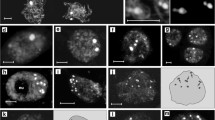Summary
The silver impregnation of nucleolar material facilitated the study of the morphological changes which take place in the nucleolus throughout the division cycle in root tip cells ofAllium cepa. The nucleolus appears to undergo no morphological changes throughout the interphase. It undergoes disorganization during the prophase, while in the telophase it appears uniformly on the chromatin as condensing into prenucleolar bodies.
The appearance of the prenucleolar bodies is unaffected by puromycin, cordycepin, or ethidium bromide. This suggests that the argyrophilic material does not undergo synthesis during the telophase, nor require RNA or protein synthesis to effect the aggregation into prenucleolar bodies. However, the organization of nucleoli from prenucleolar bodies is inhibited by both cordycepin and ethidium bromide, suggesting that RNA synthesis is involved in this proccess.
In aneuploid nuclei induced by treatment with colchicine we observed the appearance of prenucleolar bodies during the telophase even in the absence of the nucleolar organizer, but in this case the formation of nucleoli fails to take place. The nucleolar organizers proved to be capable of acting only in the nucleus to which they belong, but not on other nuclei within the same cytoplasm belonging to multinucleate cells.
It seems logical to assume that one of the roles of the nucleolar organizer is related with the above-mentioned RNA synthesis, which is required to the aggregation of prenucleolar bodies into nucleoli.
Similar content being viewed by others
References
Beermann, W., 1960: Der Nukleolus als lebenswichtiger Bestandteil des Zellkernes. Chromosoma11, 263–296.
Chouinard, L. A., 1966: Nucleolar architecture in root meristematic cells ofAllium cepa. Nat. Cancer Inst. Monogr.23, 125–143.
Das, N. K., 1962: Demonstration of a non-RNA nucleolar fraction by silver staining. Exp. Cell Res.26, 428–431.
—, 1963: Chromosomal and nucleolar RNA synthesis in root tips during mitosis. Science140, 1231–1233.
—, andM. Alfert, 1963: Silver staining of a nucleolar fraction, its origin and fate during the mitotic cycle. Ann. Histochim.8, 109–114.
De Zeeuw, J., 1936: Recherches sur les noyaux euchromocentriques et leur division (Eupinus luteus etL. hirsutus). Cellule44, 389–413.
Doutreligne, J., 1933: Chromosomes et nucleolus dans le noyaux du type euchromocentrique. Cellule42, 31–60.
Esper, H., andH. J. Barr, 1964: A study of the developmental cytology of a mutation affecting nucleoli inXenopus embryos. Develop. Biol.10, 105–121.
Fernández-Gómez, M. E., J. C. Stockert, J. F. López-Sáez, andG. Giménez-Martín, 1969: Staining plant cell nucleoli with AgNO3 after formalin-hydroquinone fixation. Stain Techn.44, 48–49.
Fischberg, M., andH. Wallace, 1960: A mutation which reduces nucleolar number inXenopus laevis. In: The cell nucleus, pp. 30–34. (Ed.Butterworth). London and Washington: J. S. Mitchell.
Gates, R. R., 1942: Nucleoli and related nuclear structures. Bot. Rev.8, 337–409.
Giménez-Martín, G., A. González-Fernández, andJ. F. López-Sáez, 1965: A new method of labelling cells. J. Cell Biol.26, 305–309.
Harris, H., 1961: Formation of the nucleolus in animal cells. Nature190, 1077–1078.
Heitz, E., 1931: Die Ursache der gesetzmäßigen Zahl, Lage, Form und Größe pflanzlicher Nukleolen. Planta12, 775–844.
Kihlman, B. A., andG. Odmark, 1966: Effects of adenine nucleosides on chromosomes, cell division and nucleic acid synthesis inVicia faba. Hereditas56, 71–82.
Lafontaine, J. G., 1958: Structure and mode of formation of the nucleolus in meristematic cells ofVicia faba andAllium cepa. J. Biophys. Biochem. Cytol.4, 777–784.
—, andL. A. Chouinard, 1963: A correlated light and electron microscope study of the nucleolar material during mitosis inVicia faba. J. Cell Biol.17, 167–209.
—, andF. A. Lord, 1966: Structure and mode of formation of the nucleolus in plant cells. Nat. Cancer Inst. Monogr.23, 67–75.
López-Sáez, J. F., G. Giménez-Martín, andA. González-Fernández, 1966: Duration of the cell division cycle and its dependence on temperature. Z. Zellforsch.75, 591–600.
Martin, P. G., 1961: Evidence for the continuity of nucleolar material in mitosis. Nature190, 1078–1079.
McClintock, B., 1934: The relation of a particular chromosomal element, in the development of the nucleoli inZea mays. Z. Zellforsch. Mikroskop. Anat.21, 294–328.
Nathans, D., 1964: Inhibition of protein synthesis by puromycin. Fed. Proc.23, 984–989.
Newton, B. A., 1963: In Metabolic inhibitors. (Ed. byR. M. Hochster andJ. H. Quastel.)2, 285. New York: Academic Press.
Rattenbury, J. A., andJ. A. Serra, 1952: Types of nucleolus reconstitution in telophase and the question of the nucleolar organizer. Port. Acta Biol. Ser. A,3, 239–260.
Stevens, B. J., 1965: The fine structure of the nucleolus during mitosis in the grasshopper neuroblast cell. J. Cell Biol.24, 349–368.
Stockert, J. C., M. E. Fernández-Gómez, andJ. F. López-Sáez, 1969: Effect of fixatives on the silver impregnation in plant cells. Stain Techn.44, 239–242.
Swift, H., 1959: Studies on nucleolar function. In: A symposium on Molecular Biology, pp. 266–303. Ed.R. E. Zirkle. Chicago: Univ. Chicago Press.
Tandler, C. J., 1959: The silver-reducing property of the nucleolus and the nucleolus and the formation of prenucleolar material during mitosis. Exp. Cell Res.17, 560–564.
—, 1966: Detection and origin of nucleolar components: a model for nucleolar RNA function. Nat. Cancer Inst. Monogr.23, 181–190.
Tjio, J., andA. Levan, 1951: The use of oxiquinoline in chromosome analysis. An. Estac. Exp. Aula Dei2, 21–64.
Van Camp, G. M., 1924: Le Rôle du nucléole dans la cáryocinèse somatique. Cellule34, 7–49.
Yarmolinsky, M. B., andG. L. de La Haba, 1959: Inhibition by puromycin of amino acid incorporation into protein. Proc. nat. Acad. Sci.45, 1721–1729.
Zirkle, C., 1928: Nucleolus in root tip mitosis inZea mays. Botan. Gaz.86, 402–418.
Author information
Authors and Affiliations
Additional information
The work reported in the paper was undertaken during the tenure of a Research Training Fellowship awarded by the International Agency for Research on Cancer.
Rights and permissions
About this article
Cite this article
Stockert, J.C., Fernández-Gómez, M.E., Giménez-Martín, G. et al. Organization of argyrophilic nucleolar material throughout the division cycle of meristematic cells. Protoplasma 69, 265–278 (1970). https://doi.org/10.1007/BF01280726
Received:
Revised:
Issue Date:
DOI: https://doi.org/10.1007/BF01280726




